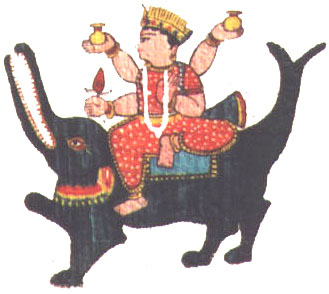Goddess Ganga and the Gangetic Dolphin
Contents
Goddess Ganga and the Gangetic Dolphin
| Discussed species | Platanista gangetica (The Ganges Dolphin) |
|---|---|
| Species distribution | Nepal, India, Bangladesh. The species is endemic in the Ganges, Brahmaputra, and Meghna river systems. Only about 1,200-1,800 individuals are left in the wild and the species has been classified as Endangered. [1][2]. |
| Comments | The Gangetic Dolphin was declared the National Aquatic Animal of India[3] |
| The story of the Ganges Dolphin is a rather sad story. Dolphins are known to be one of the most intelligent species on earth. Dolphins display creative behavior, have been shown to make rudimentary use of tools and are able to communicate with other individuals through clicks and whistles. It has been suggested recently that dolphins, given their highly intelligent behaviors, should be treated as non-human mammals[4]. Unfortunately, a large percentage of India's population may be unaware of this fact.
According to the IUCN[5], the following are the biggest threats to the Gangetic dolphins:
The Gangetic Dolphins are blind, and detect their smaller fish prey exclusively by echolocation. Their blindness, coupled with the toxicity of water and increased movement of mechanized fishing boats in the Ganga has also disrupted the feeding patterns of these Dolphins. Surprisingly, the Gangetic Dolphin has been traditionally considered a vehicle of the Goddess Ganga. Even Emperor Ashoka, in his rule, had extended the highest level of protection to the Gangetic Dolphin[6]. It is painful that not only has the river Goddess been turned into Asia's largest sewage canal but also the intelligent, living creatures in it with such great importance to Indian culture are being threatened with extinction. River dolphins also existed in the Yangtze river (Baiji) and the Indus river in Pakistan. But these are either extinct or Critically Endangered. We cannot afford to let that happen to the Gangetic (and the Brahmaputra) dolphins [7]. With only 2000 individuals left, how are we going to protect the Gangetic Dolphin? The Government of India's Ministry of Environment and Forests, in 2010, under Jairam Ramesh, declared the Gangetic Dolphin the National Aquatic Animal of India, providing it the highest level of conservation protection. Before that, the Government had also established the Vikramshila Gangetic Dolphin Sanctuary, near Bhagalpur in Bihar (see map below), to provide a safe haven to some of these dolphin populations. In 2010 and 2011, however, the number of individuals at the VGDS was only ~200, so many dolphins are still not under the cover of protection. News reports (see additional media below) suggest that despite the sanctuary being a completely river-sanctuary, there is hardly any river patrolling, the allotted budget is minuscule, fishermen still catch the dolphins in their nets, there is still illegal hunting and mechanized ferries still ply in the sanctuary without major restrictions. Increasing awareness among the fishermen, tribal groups and creating a strong pressure group for dolphin-friendly damming needs to occur at a rapid pace. Local and national NGOs are quite active in building a grassroots level movement for its conservation[8][9]. However, we need to contribute as much as we can. |
|
Additional Media
Map of the sanctuary (Bhagalpur)
References
- ^ WWF Accessed: 20 November, 2011
- ^ IUCN Red List
- ^ Govt declares dolphin national aquatic animal Oct 6, 2010
- ^ Is a Dolphin a Person? Science NOW. 21st Feb, 2010
- ^ IUCN Red list - Platanista gangetica Accessed: Nov 24, 2011
- ^ King Ashoka and Gangetic Dolphin protection Accessed: Nov 24, 2011
- ^ IUCN - Lipotes vexillifer Accessed: Nov 24, 2011
- ^ A step to save rare Gangetic dolphins
- ^ The Gangetic Dolphin Conservation Group Accessed: Nov 24, 2011
Comments
blog comments powered by DisqusMore notes like this
| |||||||||||||||||||||||||||||||||||||||||||||||||||||||||||||||||||||||||||||||||||||
Only 15 articles are shown in this list. A total of 64 articles in the database as of this moment. For the complete list, click on further results on the bottom right corner of the above table.
Semantic tags
- Browse all Semantic Tags associated with this page
- Find more pages and articles created by the community by clicking this link.
| Title | Goddess Ganga and the Gangetic Dolphin | Article is on this general topic | Mythology and religion | Author | Gaurav Moghe |
|---|---|---|---|---|---|
| Specific location(s) where study was conducted | Not noted | General region where study was conducted | Not noted | State where study was conducted | Pan-India |
| Institutional affiliation | Not noted | Institution located at | Not noted | Institution based around | Not noted |
| Species Group | Mammals | User ID | User:Gauravm | Page creation date | 2011/11/24 |
Share this page:
